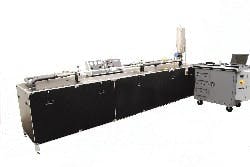The new Positive Displacement Calibrators, Liquid (PDCL) primary standard flowmeter calibrators offer enhanced
features enabling the most precise liquid flow calibrators available, ranging from 0.01 GPM (0.04 LPM) to 400 GPM (1514 LPM) with an uncertainty of ±0.05% and a repeatability of 0.01% of reading. The PDCL is a precision
volumetric device displacing an exact, known volume of fluid, which passes through the flowmeter under test while compensating for fluid viscosity and temperature. All models are capable of performing NIST-traceable calibrations on most common flowmeters, including turbine, differential pressure, orifice plate, rotameter, variable area, coriolis or any other type of meter that has a visual, pulse, or analog output.
The PDCL calibrator consists of a precision-honed and polished cylinder assembly, with a piston mechanically connected with a displacement shaft. The travel of the piston is measured with a high-resolution linear encoder. One side of the piston is actuated pneumatically, while the other side displaces a controlled amount of fluid through the meter under test. The flow is regulated by three control valves—course, medium and fine—to obtain the exact flow rate required. The fluid is collected in a reservoir tank and returned to the cylinder, bypassing the meter under test. A temperature control system maintains the fluid temperature to create the desired
calibration conditions. The calibrator can be fully automated to establish the flow rates and collect calibration data. Additional automated features consist of automatic fluid air bleed; servo-driven, telescoping flowmeter section; and flowmeter clamping fixture.
The electronic output from the calibrator’s encoder, temperature sensors, and the meter under test are signal conditioned and collected with a computer data acquisition system. An integral part of the PDCL system is the “Flo-Cal” Windows-based software program, which collects, reduces, plots, prints and stores calibration data. This program allows the user to change screen displays, data sheet formats and data reduction equations on line,
without using source code and compilers. As new requirements for calibration processes, data or correlations arise, the program may be changed by the user to meet these requirements.

